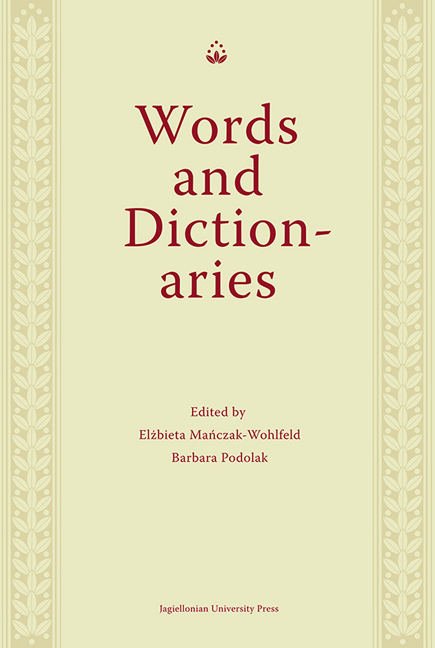 Words and Dictionaries
Words and Dictionaries Published online by Cambridge University Press: 18 January 2018
The suggested etymologies
The meaning and etymology/ies of #x1F10;#x03BD;#x1F77;#x03C0;#x03C4;#x03C9;#x002C;#x0020;#x1F10;#x03BD;#x1F77;#x03C3;#x03C3;#x03C9; (both ‘I insult’), #x1F10;#x03BD;#x1F77;#x03C8;#x03C9; ‘I will speak’, #x1F34;#x03C8;#x03B1;#x03BF; ‘you inflicted serious pain’, #x1F30;#x03AC;#x03C0;#x03C4;#x03C9; ‘I hurt, throw down’, #x03C0;#x03C1;#x03BF;#x0390;#x03B1;#x03C8;#x03B5; ‘he threw down, he sent to Hades’, #x1F10;#x03BD;#x03AD;#x03BD;#x1FD1;#x03C0;#x03B5; ‘he insulted’ and #x1F20;#x03BD;#x1F77;#x03C0;#x03B1;#x03C0;#x03B5; ‘he attacked (with a word), he insulted’ have posed problems for centuries. In what follows, an overview of the etymologies suggested so far will be given:
1. The verb #x1F10;#x03BD;#x03AF;#x03C0;#x03C4;#x03C9; was explained as a reduplicated present with ie/o suffix built on *uekw. The evolution was *eni-ui-ukw -ie/o > *eni-ui-ikw-ie/o with dissimilation > *eni-uīkw -ie/o > *eni-īkwie/o with disappearance of the intervocalic digamma > *enīkw-ie/o with contraction> #x1F10;#x03BD;#x03AF;#x03C0;#x03C4;#x03C9;#x002F;#x1F10;#x03BD;#x03AF;#x03C3;#x03C3;#x03C9;#x002E;. The reduplicated aorists ἠνίπαπε and #x1F10;#x03BD;#x03AD;#x03BD;#x1FD1;#x03C0;#x03B5; were explained as secondary inner-Greek creations.
There are nevertheless some issues with this reconstruction:
a. It supposed a contraction after the intervocalic digamma had fallen out, but if this verb had been an old inherited formation, the digamma would in all likelihood have been preserved.
b. The supposed dissimilation *eni-ui-ukw into *eni-uiikw seems to be contradicted by the so-called boukolos rule.6 An analogical restoration of the *u can only be assumed if the connection with *uekwos was still active. Beckwith is in our opinion right in assuming that this link was no longer felt by the speakers, contrary to the reduplicated aorist *ueukw-in which the *u was restored by the parallel with *uekwos.
c. The root *uekw is not attested in the present in Greek until very late,8 if it is to be linked with this root at all: the form ἐνέπουσι could belong to *sekw as well. There is no Greek parallel for Sanskrit vivakti and Latin invocare: the former is an athematic reduplicated form based on the full grade (and could be late),9 and the latter is based on the o grade. In addition, the coexistence of a reduplicated present and reduplicated aorist is very rare:10 the only certain example in Greek is Ἀ #x03C1;#x03B1;#x03C1;#x03AF;#x03C3;#x03BA;#x03C9;, which is a present that was built on the reduplicated aorist #x1F24;#x03C1;#x03B1;#x03C1;#x03BF;#x03BD;
To save this book to your Kindle, first ensure [email protected] is added to your Approved Personal Document E-mail List under your Personal Document Settings on the Manage Your Content and Devices page of your Amazon account. Then enter the ‘name’ part of your Kindle email address below. Find out more about saving to your Kindle.
Note you can select to save to either the @free.kindle.com or @kindle.com variations. ‘@free.kindle.com’ emails are free but can only be saved to your device when it is connected to wi-fi. ‘@kindle.com’ emails can be delivered even when you are not connected to wi-fi, but note that service fees apply.
Find out more about the Kindle Personal Document Service.
To save content items to your account, please confirm that you agree to abide by our usage policies. If this is the first time you use this feature, you will be asked to authorise Cambridge Core to connect with your account. Find out more about saving content to Dropbox.
To save content items to your account, please confirm that you agree to abide by our usage policies. If this is the first time you use this feature, you will be asked to authorise Cambridge Core to connect with your account. Find out more about saving content to Google Drive.